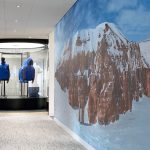![]() The Timberland Company reported a second-quarter 2010 net loss of $23.5 million, or 44 cents a share, after a $13.2 million pre-tax charge for the impairment of certain goodwill and intangible assets. In the year-ago period, the company lost $19.2 million, or 34 cents a share. Revenue increased 5.1% to $189.0 million, reflecting growth across North America, Asia, and Europe.
The Timberland Company reported a second-quarter 2010 net loss of $23.5 million, or 44 cents a share, after a $13.2 million pre-tax charge for the impairment of certain goodwill and intangible assets. In the year-ago period, the company lost $19.2 million, or 34 cents a share. Revenue increased 5.1% to $189.0 million, reflecting growth across North America, Asia, and Europe.
Second-Quarter 2010 Results Summary:
North America revenue increased 6.6% to $92.0 million compared to the prior year period, driven by growth in apparel and accessories. Europe revenue increased 1.4% to $66.8 million versus 2009 second-quarter levels, and increased 5.7% on a constant dollar basis. Double-digit growth in Italy, Germany, and Scandinavia was partially offset by declines in the UK and France as well as the impact from the strengthening of the U.S. Dollar. Asia revenue increased 9.6% to $30.2 million compared to the prior year period, and increased 4.8% on a constant dollar basis. Favorable foreign exchange rates, along with the continuation of significant growth in Taiwan and China compared to the prior year period, were partially offset by declines in the Asia distributor business.
Global footwear revenue increased 3.7% to $131.6 million from the second quarter of 2009, driven primarily by increased sales of our Timberland PRO footwear in North America and a strong performance by the Europe wholesale business, partially offset by weakness in Europe retail stores. Apparel and accessories revenue increased 10.2% to $52.1 million compared to the prior year period, due to increased sales of SmartWool accessories in North America and Timberland brand apparel in Asia retail stores, partially offset by softness in Europe. Royalty and other revenue decreased 3.8% to $5.3 million compared to the prior year period primarily due to a decline in licensed kids' apparel in North America.
Global wholesale revenue was up 8.3% to $117.5 million compared to the prior year period, due to double-digit growth in North America and Europe, partially offset by declines in Asia. Worldwide consumer direct revenue was flat compared to the prior year period, as improved comparable store sales in Asia and the net addition of 8 new Asia retail stores since the second quarter of 2009 were offset by declines in Europe and North America. Overall, comparable store sales were flat versus the second quarter of 2009. The company had 224 stores, shops, and outlets worldwide at the end of the second quarter of 2010 compared to 220 at the end of the second quarter of 2009.
Operating loss for the second quarter of 2010 was $33.3 million compared to an operating loss of $36.4 million in the prior year period. A significant improvement in gross margin due primarily to favorable pricing and channel mix as well as lower input costs was partially masked by a non-cash impairment charge of $13.2 million primarily related to certain goodwill and intangible assets of the IPATH and howies brands.
In the second quarter of 2010, the effective tax rate was 29.0% compared to 44.3% in the second quarter of 2009.
In connection with its stock buyback program, the company repurchased approximately 1.3 million shares in the second quarter of 2010 at a cost of approximately $25.0 million.
The company ended the quarter with $237.8 million in cash and no debt. Accounts receivable decreased 13.3% to $86.8 million compared to the prior year period. Inventory at quarter end was $177.2 million, down 1.8% versus 2009 second-quarter levels, reflecting the Company's continued focus on working capital.
Jeffrey B. Swartz, Timberland's president and CEO, stated, “We are pleased to report revenue growth and gross margin improvement in all three regions. These results were achieved by focusing on our core outdoor equities and executing against a consistent strategy to strengthen our brand globally. We are optimistic about the progress that we are making, despite ongoing cost pressures and macroeconomic uncertainty in key markets. While non-cash charges impacted our profitability for the quarter, our core business saw marked improvement, a clear indication that our product and brand initiatives are continuing to gain traction and that Timberland is positioned for long-term success.”
| THE TIMBERLAND COMPANY | |||||||||||||
| UNAUDITED CONDENSED CONSOLIDATED BALANCE SHEETS | |||||||||||||
| (Dollars in Thousands) | |||||||||||||
| July 2, 2010 | December 31, 2009 | July 3, 2009 | |||||||||||
| Assets | |||||||||||||
| Current assets | |||||||||||||
| Cash and equivalents | $ | 237,798 | $ | 289,839 | $ | 183,919 | |||||||
| Accounts receivable, net | 86,836 | 149,178 | 100,126 | ||||||||||
| Inventory, net | 177,206 | 158,541 | 180,392 | ||||||||||
| Prepaid expense | 31,506 | 32,863 | 35,121 | ||||||||||
| Prepaid income taxes | 27,244 | 11,793 | 24,720 | ||||||||||
| Deferred income taxes | 27,085 | 26,769 | 19,024 | ||||||||||
| Derivative assets | 7,882 | 1,354 | 2,284 | ||||||||||
| Total current assets | 595,557 | 670,337 | 545,586 | ||||||||||
| Property, plant and equipment, net | 64,502 | 69,820 | 74,185 | ||||||||||
| Deferred income taxes | 18,683 | 14,903 | 17,480 | ||||||||||
| Goodwill and intangible assets, net | 75,153 | 89,885 | 90,442 | ||||||||||
| Other assets, net | 12,670 | 14,962 | 14,971 | ||||||||||
| Total assets | $ | 766,565 | $ | 859,907 | $ | 742,664 | |||||||
| Liabilities and Stockholders†Equity | |||||||||||||
| Current liabilities | |||||||||||||
| Accounts payable | $ | 78,946 | $ | 79,911 | $ | 71,423 | |||||||
| Accrued expense and other current liabilities | 80,555 | 125,500 | 76,659 | ||||||||||
| Income taxes payable | 15,330 | 21,959 | 533 | ||||||||||
| Deferred income taxes | 388 | 48 | 0 | ||||||||||
| Derivative liabilities | 91 | 389 | 4,565 | ||||||||||
| Total current liabilities | 175,310 | 227,807 | 153,180 | ||||||||||
| Other long-term liabilities | 38,234 | 36,483 | 35,809 | ||||||||||
| Stockholders†equity | |||||||||||||














